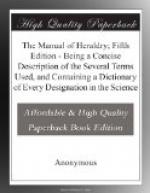DRAGON. An imaginary monster; a mixture of beast,
bird, and reptile.
It is frequently borne in crests and charges.
[Illustration: Dragon]
Ex. Argent, a dragon proper, tail nowed.
DRAGON’S HEAD. Part of a celestial constellation, used by ancient English heralds to denote tenne when emblazoning the arms of sovereigns; this style of heraldry has become obsolete.
DRAGON’S TAIL. Part of the same constellation; formerly used to denote sanguine.
DUKE. The highest degree of British peerage next to the prince of Wales. This title is derived from the Latin word dux: the title of Duke was known in other parts of Europe long before it was introduced into England. The first person that was created a duke in this country was Edward the Black Prince, who was created duke of Cornwall by his father Edward the third. The title has since that time belonged to the first born son of the monarch of England. A duke formerly possessed great authority over the province that formed his dukedom, and had large estates annexed to his title to support its dignity. At the present time dukes are created by patent, and their dukedom is merely nominal, neither power nor possessions being annexed to the title.
EAGLE. Aquila in Ornithology. In Heraldry the eagle is accounted one of the most noble bearings, and ought to be given only to such as greatly excel in the virtues of generosity and courage, or for having done some singular service to their sovereign.
EAGLET is a diminutive of eagle, properly signifying a young eagle. In Heraldry, when several eagles are on the same escutcheon, they are termed eaglets.
EARL. The third degree of British peerage. Under the Danish and Saxon kings this was the highest title known in England conferred upon a subject. It was formerly the custom upon creating an earl to assign him, for the support of his state, the third penny from the fines and profits of the sheriff’s court, issuing out of the pleas of the shire whence the earl took his title; as, formerly, there was no count or earl but had a county or shire for his earldom. When the number of earls was increased, they took their titles from towns and villages. An earl is now created by patent.
EARL-MARSHAL OF ENGLAND. A very ancient, and formerly a very important, officer, who had several courts under his jurisdiction, as the Court of Chivalry, the Court of Honour. He still presides over the Heralds’ College, and nominally over the Marshalsea Court. The title of Earl Marshal of England is now, and has been for some ages, hereditary in the noble family of the Howards.
EASTERN CROWN. A crown with rays proceeding from a circle, called by heralds an Eastern crown, is found in ancient achievements. The annexed cut shows its form.
[Illustration: Eastern Crown]
EMBATTLED. A line, formed like the battlements on a wall or tower, is said to be embattled or crenelle. When the line is used to form one of the ordinaries, it is said to be embattled. See the lines, p. 11. [CHAP. III.]




